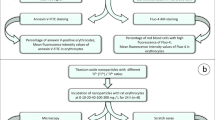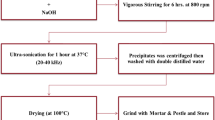Abstract
Titanium dioxide nanoparticles are massively produced and widely used in daily life, which has posed potential risk to human health. However, the molecular mechanism of TiO2 nanoparticles (NPs) with different crystal phases is not clear. In this study, the characterization of two crystalline phases of TiO2 NPs is evaluated by transmission electron microscopy and X-ray absorption fine structure spectrum; an interaction of these TiO2 NPs with HaCaT cells is studied in vitro using transmission electron microscopy, chemical precipitation method, and X-ray absorption fine structure spectrometry. The coordination and surface properties indicate that only the anatase–TiO2 NPs allow spontaneous reactive oxygen species (ROS) generation, but rutile–TiO2 NPs do not after dispersion. The interaction between TiO2 NPs and cellular components might also generate ROS for both anatase–TiO2 NPs and rutile–TiO2 NPs. The ROS generation could lead to cellular toxicity if the level of ROS production overwhelms the antioxidant defense of the cell or induces the mitochondrial apoptotic mechanisms. Furthermore, Ti had a direct combination with some protein or DNA after NPs enter the cell, which could also lead to cellular toxicity.







Similar content being viewed by others
References
Allen NS et al (2005) Photocatalytic coatings for environmental applications. Photochem Photobiol 81(2):279–290 (in English)
Wolf R, Matz H, Orion E, Lipozencic J (2003) Sunscreens—the ultimate cosmetic. Acta Dermatovenerol Croat 11(3):158–162 (in English)
Kaida T, Kobayashi K, Adachi M, Suzuki F (2004) Optical characteristics of titanium oxide interference film and the film laminated with oxides and their applications for cosmetics. J Cosmet Sci 55(2):219–220 (in English)
Zhang AP, Sun YP (2004) Photocatalytic killing effect of TiO2 nanoparticles on Ls-174-t human colon carcinoma cells. World J Gastroenterol 10(21):3191–3193 (in English)
Nel A, Xia T, Madler L, Li N (2006) Toxic potential of materials at the nanolevel. Science 311(5761):622–627 (in English)
Auffan M et al (2009) Towards a definition of inorganic nanoparticles from an environmental, health and safety perspective. Nat Nanotechnol 4(10):634–641 (in English)
Ramires PA, Romito A, Cosentino F, Milella E (2001) The influence of titania/hydroxyapatite composite coatings on in vitro osteoblasts behaviour. Biomaterials 22(12):1467–1474 (in English)
Brumfiel G (2003) Nanotechnology: a little knowledge. Nature 424(6946):246–248 (in English)
Li N et al (2010) Interaction between nano-anatase TiO2 and liver DNA from mice in vivo. Nanoscale Res Lett 5(1):108–115, in English
Wang J et al (2008) Potential neurological lesion after nasal instillation of TiO(2) nanoparticles in the anatase and rutile crystal phases. Toxicol Lett 183(1–3):72–80 (in English)
Colvin VL (2003) The potential environmental impact of engineered nanomaterials. Nat Biotechnol 21(10):1166–1170 (in English)
Service RF (2004) Nanotoxicology. Nanotechnology grows up. Science 304(5678):1732–1734 (in English)
Xia T et al (2006) Comparison of the abilities of ambient and manufactured nanoparticles to induce cellular toxicity according to an oxidative stress paradigm. Nano Lett 6(8):1794–1807 (in English)
Dreher KL (2004) Health and environmental impact of nanotechnology: toxicological assessment of manufactured nanoparticles. Toxicol Sci 77(1):3–5 (in English)
Hirakawa K, Mori M, Yoshida M, Oikawa S, Kawanishi S (2004) Photo-irradiated titanium dioxide catalyzes site specific DNA damage via generation of hydrogen peroxide. Free Radic Res 38(5):439–447 (in English)
Braydich-Stolle LK et al (2009) Crystal structure mediates mode of cell death in TiO2 nanotoxicity. J Nanopart Res 11(6):1361–1374, in English
Rehr JJ, Albers RC, Zabinsky SI (1992) High-order multiple-scattering calculations of X-ray-absorption fine structure. Phys Rev Lett 69(23):3397–3400 (in English)
Troger L et al (1994) Determination of bond lengths, atomic mean-square relative displacements, and local thermal expansion by means of soft-X-ray photoabsorption. Phys Rev B Condens Matter 49(2):888–903 (in English)
Gupta AK, Gupta M (2005) Cytotoxicity suppression and cellular uptake enhancement of surface modified magnetic nanoparticles. Biomaterials 26(13):1565–1573 (in English)
Wilhelm C et al (2003) Intracellular uptake of anionic superparamagnetic nanoparticles as a function of their surface coating. Biomaterials 24(6):1001–1011 (in English)
Wang JJ, Sanderson BJ, Wang H (2007) Cyto- and genotoxicity of ultrafine TiO2 particles in cultured human lymphoblastoid cells. Mutat Res 628(2):99–106 (in English)
Gupta AK, Berry C, Gupta M, Curtis A (2003) Receptor-mediated targeting of magnetic nanoparticles using insulin as a surface ligand to prevent endocytosis. IEEE Trans Nanobioscience 2(4):255–261 (in English)
Kim JS et al (2006) Cellular uptake of magnetic nanoparticle is mediated through energy-dependent endocytosis in A549 cells. J Vet Sci 7(4):321–326 (in English)
Grunes LA (1983) Study of the K edges of 3d transition metals in pure and oxide form by X-ray-absorption spectroscopy. Phys Rev B 27:2111–2131
Hamann DR (1997) Adaptive-coordinate electronic structure of 3d bands: TiO2. Phys Rev B 56(23):14979–14984 (in English)
Vittadini A, Selloni A, Rotzinger FP, Gratzel M (1998) Structure and energetics of water adsorbed at TiO2 anatase (101) and (001) surfaces. Phys Rev Lett 81(14):2954–2957 (in English)
Kim SK, Hwang GW, Kim WD, Hwang CS (2006) Transformation of the crystalline structure of an ALD TiO2 film on a Ru electrode by O-3 pretreatment. Electrochem Solid St 9(1):F5–F7 (in English)
Grassian VH, O'Shaughnessy PT, Adamcakova-Dodd A, Pettibone JM, Thorne PS (2007) Inhalation exposure study of titanium dioxide nanoparticles with a primary particle size of 2 to 5 nm. Environ Health Perspect 115(3):397–402 (in English)
Nel A (2005) Atmosphere. Air pollution-related illness: effects of particles. Science 308(5723):804–806 (in English)
Donaldson K, Stone V, Tran CL, Kreyling W, Borm PJ (2004) Nanotoxicology. Occup Environ Med 61(9):727–728 (in English)
Rothen-Rutishauser B, Muhlfeld C, Blank F, Musso C, Gehr P (2007) Translocation of particles and inflammatory responses after exposure to fine particles and nanoparticles in an epithelial airway model. Part Fibre Toxicol 4:9 (in English)
Geiser M et al (2005) Ultrafine particles cross cellular membranes by nonphagocytic mechanisms in lungs and in cultured cells. Environ Health Perspect 113(11):1555–1560 (in English)
Long TC, Saleh N, Tilton RD, Lowry GV, Veronesi B (2006) Titanium dioxide (P25) produces reactive oxygen species in immortalized brain microglia (BV2): implications for nanoparticle neurotoxicity. Environ Sci Technol 40(14):4346–4352 (in English)
Acknowledgments
This work was financially supported by a project supported by the State Key Development Program for Basic Research of China (grant no. 2006CB932505) and project supported by the Shanghai Committee of Science and Technology, China (grant no. 0752nm020). The authors would like to express their thanks to the XAFS station of the Shanghai Synchrotron Radiation Facility.
Author information
Authors and Affiliations
Corresponding author
Additional information
Chan Jin and Ying Tang contributed equally to this work.
Rights and permissions
About this article
Cite this article
Jin, C., Tang, Y., Yang, F.G. et al. Cellular Toxicity of TiO2 Nanoparticles in Anatase and Rutile Crystal Phase. Biol Trace Elem Res 141, 3–15 (2011). https://doi.org/10.1007/s12011-010-8707-0
Received:
Accepted:
Published:
Issue Date:
DOI: https://doi.org/10.1007/s12011-010-8707-0




